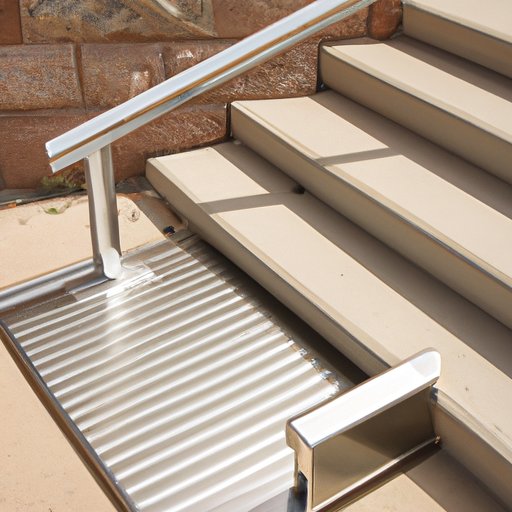Introduction
Aluminum ramps are a popular choice for providing accessible entry into homes, buildings, and other structures. They are durable, lightweight, and low-maintenance, making them an ideal solution for both residential and commercial applications. In this article, we’ll take a look at the benefits of aluminum ramps, how to choose the right one for your needs, and design and installation considerations.

Advantages of Using Aluminum for Ramp Construction
Aluminum is an excellent material choice for building ramps due to its strength, durability, and low maintenance requirements. It is also lightweight, making it easy to transport and install, yet strong enough to support the weight of wheelchairs and other mobility devices. Additionally, aluminum is cost-effective and long-lasting, which makes it a great investment for any home or business.
Aluminum ramps can also be customized with a variety of colors and finishes, allowing you to create a unique look that complements the existing architecture. This makes them a great option for creating a stylish and functional entrance for any space.
How to Choose the Right Aluminum Ramp for Your Needs
When selecting an aluminum ramp, there are several factors to consider, including measurements and dimensions, load capacity, and accessibility requirements. It is important to choose a ramp that is designed to meet your specific needs and will provide safe, reliable access.
Measurements and Dimensions: When choosing an aluminum ramp, it is important to consider both the length and width of the ramp. The length should be based on the overall rise of the structure, while the width should accommodate the type of mobility device being used. For example, if a wheelchair is the primary user, the ramp should be at least 36 inches wide.
Load Capacity: Another important factor to consider when selecting an aluminum ramp is the load capacity. This refers to the maximum weight that the ramp can safely support. Be sure to select a ramp that is designed to accommodate the weight of the user and any additional items they may be carrying.
Accessibility Requirements: Depending on the application, there may be additional accessibility requirements that need to be met. For example, some local building codes require handrails and guardrails on ramps, as well as non-slip surfaces for added safety. It is important to check with your local building authority to ensure that your ramp meets all applicable regulations.
Design Considerations for Building an Aluminum Ramp
In addition to the above factors, there are several design considerations to keep in mind when designing an aluminum ramp. These include the slope and rise, placement and location, and handrails and guardrails.
Slope and Rise: The slope and rise of the ramp should be designed to provide safe, comfortable access for users. Generally, the slope should not exceed 1:12, meaning that for every 12 inches of rise, the ramp should span at least one foot. Additionally, the maximum rise should not exceed 30 inches.
Placement and Location: The location of the ramp is also important, as it should provide convenient access to the structure. It is best to place the ramp close to the main entrance, so that it can be easily accessed. Additionally, the ramp should be placed away from any obstacles or hazards that could impede access.
Handrails and Guardrails: Handrails and guardrails should also be included on the ramp to provide additional stability and safety. The handrails should be positioned at a height that is comfortable and easy to grasp, and the guardrails should be installed at the sides of the ramp to prevent users from falling off the edge.
Installation Tips for an Aluminum Ramp
Once you have selected the appropriate aluminum ramp for your needs, the next step is to install it. Here are some tips to ensure a successful installation:
Preparing the Site: Before installing the ramp, it is important to prepare the site. This includes leveling the ground and removing any debris or obstacles that could impede access. It is also important to check that the area is free of moisture or standing water, as this can cause the ramp to become slippery.
Assembling and Securing the Ramp: Once the site is prepared, the next step is to assemble the ramp. Make sure to follow the manufacturer’s instructions carefully, and use the appropriate tools and hardware to secure the ramp in place. Additionally, be sure to use a level to ensure that the ramp is properly aligned.

Maintenance and Care for an Aluminum Ramp
Once the aluminum ramp is installed, it is important to perform regular inspections to ensure that it remains safe and functional. This includes checking for loose bolts or other signs of wear, as well as cleaning the ramp regularly to remove dirt and debris. Additionally, any repairs or modifications should be done promptly to avoid further damage.

The Future of Aluminum Ramps in Accessibility Solutions
The demand for accessible structures is increasing, and aluminum ramps are becoming an increasingly popular choice for providing safe and reliable access. As more people recognize the benefits of aluminum ramps, innovative designs and applications are being developed to meet the growing demand.
Conclusion
Aluminum ramps are an excellent choice for providing accessible entry into homes, buildings, and other structures. They are durable, lightweight, and low-maintenance, making them a cost-effective and long-lasting solution. When selecting an aluminum ramp, it is important to consider measurements and dimensions, load capacity, and accessibility requirements. Additionally, proper design and installation are essential for ensuring a safe and functional ramp. With proper care and maintenance, an aluminum ramp can provide safe and reliable access for years to come.

